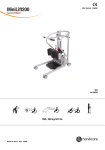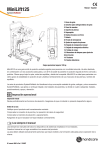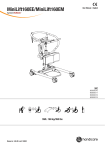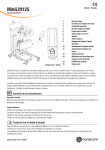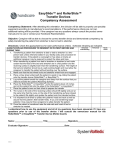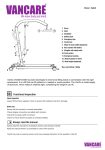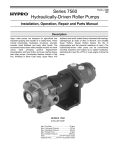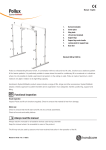Download YORKS MINILIFT 125 USER MANUAL
Transcript
Manual - English 2 3 YORKS MINILIFT 125 USER MANUAL 4 5 6 7 8 10 9 11 12 A 1. 2. 3. 4. 5. 6. 7. 8. 9. 10. 11. 12. 13. 14. 14 13 1 10 7 2 9 3 4 8 12 11 6 5 15 SWL: 125 kg/275 lbs NAME DRAWN 2010-07-27 APPROVED BY STATUS: C D E F G 15. DATE hc-jope B Lift arm Hooks for lift vest/sling Handset Leg support Footplate Rear castor wheels with brakes Battery Emergency stop Adjustment of leg support Manual emergency lowering Electrical emergency lowering Charging lamp Locking mechanism for adjustment of lift arm Handles Front castors TITLE COMMENTS: Unless otherwise stated, general tolerances according to ISO 2768-m SIZE DWG. NO. REV. A2 MiniLift125 is a mobile sit-to-stand lift for people with impaired mobility. In combination with the right accessories, it is MATERIAL: SCALE:1:4 2 WEIGHT: g SHEET 1 OF 1 designed to assist a patient comfortably and conveniently to a standing position. It provides support under the feet, 3 4 5 6 7 8 9 10 11 12 against the shins and behind the back. MiniLift125 is appropriate for patients who have a degree of stability while standing. MiniLift125 helps to train the patient’s leg muscles and sense of balance. Handicare’s SystemRoMedic product series includes a range of lifts, slings and other accessories. SystemRoMedic adopts a holistic approach to patient transfers and is organized in four categories: transfer, positioning, support and lifting. Functional inspection Visual inspection Inspect lift functions regularly. Check to ensure that material is free from damage. Before use: Ensure that the product is correctly assembled. Check slingbar connection and safety latch function. Check lift and base-width movement. Check to ensure that the actuator is correctly installed. Always read the manual Always read the manuals for all assistive devices used during a transfer. Keep the manual where it is accessible to users of the product. The lift may only be used by persons who have received instruction in the operation of the lift. Manual nr: 00884 En Ver. 4 110614 Table of contents Assembly of MiniLift125.......................................................... 3 - Final inspection . ................................................................................... 4 Using the product....................................................................5-10 - Important information . ........................................................................ 5 - Safe working load.................................................................................. 5 - The control box and battery have the following features............................. 6 - Charging batteries.................................................................................. 6 - Handset................................................................................................. 7 - Emergency stop..................................................................................... 7 - Emergency lowering............................................................................... 7 - Instructions for use................................................................................ 8 - Using MiniLift125................................................................................... 9 - Trouble-shooting ..................................................................................10 Accessories...................................................................................10 Maintenance. ............................................................................... 11 Technical information..............................................................12 - Dimensions...........................................................................................13 2 MANUAL Assembly of MiniLift125 Check to ensure that all components are included: Lift motor, control box, battery pack, base with motor, footplate, handset and cord, manual and charging cable. Screws and screw covers should also be included (see below). Assembly: Place the upper section on the lower section and lower it carefully into place (picture 1). Press it fully into place and 1 tighten all four screws. Finally, place the plastic covers over the screws (picture 2). 2 3 4 5 6 7 8 9 10 11 12 13 14 15 16 A A 1 2 3 4 5 6 7 8 9 10 11 12 13 14 15 16 A A B B B B C C C C D D D D E E E E F F F F G G G G H H H H J J J J K K K K NAME L 2 DRAWN STATUS: Unless otherwise stated, general tolerances according to ISO 2768-m DRAWN 1 DATE 2010-04-26 TITLE COMMENTS: NAME L hc-mabr APPROVED BY M APPROVED BY DATE hc-mabr SIZE DWG. NO. REV. A1 MATERIAL: 2010-04-26 SCALE:1:1 1 STATUS: 2 3 4 5 6 7 8 9 10 11 WEIGHT: g SHEET 1 OF 1 12 TITLE COMMENTS: Unless otherwise stated, general tolerances according to ISO 2768-m SIZE DWG. NO. REV. A1 MATERIAL: M SCALE:1:3 1 2 3 4 5 6 7 8 9 10 11 WEIGHT: g SHEET 1 OF 1 12 Mount the footplate on the crossbar and then lower it (picture 3). 3 Mount the leg support by inserting the crossbars on the back into the fixtures on the lift (4), and then tighten. 4 Connect cables: Handset cord in HS, cable for lift unit on mast in outlet M1 and cable for base-width motor in outlet M2 (5). 5 HS M1 M2 MANUAL 3 F Final inspection G Check to ensure that no parts have been left in the packaging. Inspect the lift for signs of wear and damage. H Check all four castor wheels and castor wheel locks. Check all connections and fixtures including screws and bolts. J K L DRAWN STATUS: COMMENTS: Unless otherwise tolerances acc pressing either the up or down button. If nothing happens when the up or down M buttons are pressed, the emergency stop is functioning properly. 1 2 3 4 5 6 7 8 9 10 Grasp the handset, press the up button and run the lift arm all the way up. Then, press the down button and run the lift arm all the way down. Test base-width adjustment function. Press the button for base-width adjustment to widen the base fully, and then press the other button to narrow the base again. Test lift function by lifting a person (not a patient) using an approved sling. At the same time, check the emergency lowering function with someone on the lift. See section on Emergency lowering. If the lift is functioning correctly, connect the charger and check to ensure that the charging lamp on the control box lights up. NOTE! Before the lift is used for the first time, it must be charged for at least 4 hours. See section on charging batteries. Keep the manual where it is accessible to users of the product. 4 h APPROVED BY Check the emergency stop function by depressing the emergency stop, and then MANUAL 11 12 Using the product Important Information • The lift must be assembled according to the assembly instructions provided with the lift. • The lift may only be used indoors and on a level floor. • Lifting accessories must be properly trial fitted and tested in relation to the patient’s needs and functional ability. • Do not leave the patient unattended during a transfer situation. • Under no circumstances may max. load be exceeded. See section on Safe working load. • Never move the lift by pulling on the actuator! Do not push • The lift must not come in direct contact with water. • The lift must not be charged in a wet room. • To ensure optimal function, the lift must be inspected regularly. See section on Maintenance. • Warranty applies only if repairs or alterations are done by an authorized technician. Safe working load Different products on the same lift system (lift unit, slingbar, sling, scales and other lifting accessories) may have different allowable safe working loads. The lowest allowable safe working load always determines the safe working load of the assembled system. Always check the safe working loads for the lift and accessories before use. Contact your dealer if you have any questions. MANUAL 5 The control box and battery have the following features 1. 2. 3. 4. 5. 6. 7. 8. 9. 9 Emergency stop Charging lamps Display showing battery charge level Charger cable Connection for base-width adjustment motor Connection for lift arm actuator Connection for handset Electrical emergency lowering Handle for lifting battery 2 8 1 2 3 4 7 6 5 Charging batteries A tone when using the lift indicating that the batteries need recharging. Charge the lift after use to ensure that the battery is always fully charged. Lock the castor wheels when charging the battery. 1. Connect the charging cable to a power outlet. 2. Check to ensure that the lamps on the control box light up. The green LED lamp indicates that the charger is receiving power and the yellow LED lamp indicates that the battery is charging. 3. Charging stops automatically when the battery is fully charged. Wall-mounted charger. 1. Remove the battery pack from the hoist and place it in the wall-mounted charger. 2. Check to ensure that the LED lamp on the front of the charger lights up. NOTE! Before the lift is used for the first time, it must be charged for at least 4 hours. For maximum battery life, charge batteries regularly. We recommend daily charging when the lift is used daily. The emergency stop button must be pulled out during charging. 6 MANUAL Handset Raising/lowering the lift arm Symbol indicate direction of travel. Motion stops as soon as the button is released. Widening/narrowing the base Markings on the buttons indicate function. Motion stops as soon as the buttons are released. Emergency stop To activate emergency stop: Depress the red emergency stop button on the control box. Resetting: Turn the button in the direction of the arrows until the button pops out. Emergency lowering Manual emergency lowering: Mechanical emer- Lift the red regulator upward. gency lowering Electrical emergency lowering: For electrical emergency, use the down button on the control box. Electrical emergency lowering MANUAL 7 Instructions for use These instructions must be followed for correct use of MiniLift125. Caution: The actuator does not lower the lift arm when the lift is being lowered. This reduces the risk of the patient being pinched by the lift arm, but as a result, the lift arm may at first catch, and then suddenly fall. To prevent this, the lift arm must be loaded throughout the entire lowering procedure, so that it is always supported by the actuator. Handset functions: The handset has four functions: up and down (lift arm), out and in (base width). Two functions cannot be used at the same time. NOTE: The handset functions do not operate if the emergency stop button is pushed in. Transferring and lifting the patient: The width of the base must be correctly adjusted to ensure optimal safety. NOTE: MiniLift125 is not intended for transporting patients. It may only be used for short transfers. Caution: Never move the lift by pulling on the actuator. Caution: Ensure that the patient’s feet do not get caught between the footplate and the floor. Ensure that the patient’s feet do not get caught between the footplate and the base when adjusting the base width. 8 MANUAL Using MiniLift125 Place an appropriately sized ThoraxSling behind and below the patient’s hips, (see manual for ThoraxSling). When the patient has placed /his/her feet on the footplate, move the lift forward towards the patient. Place the lift as close as possible to the patient. Take care to ensure that the patient’s shins are resting securely against the leg support, and then adjust the leg support so that it does not press against the patient’s kneecaps (about 2 cm lower). Raise the locking handle on the lift arm (2) and pull the lift arm out as far as possible towards the patient. Select the sling loop that reaches the hook on the boom (shortest loop alternative). Hook the lift loops to the underside of the slingbar. Raise the locking handle and draw the boom back, so that the lift straps on the sling are stretched, and then lower the locking handle back into position. Instruct the patient to lean back and allow himself/herself to be supported behind the back during raising. Raise the lift to the desired height and ensure that the patient is standing with both feet on the footplate and is grasping the slingbar handles with both hands to avoid being pinched between the slingbar and lift loops. Helpful hint: Use a longer loop alternative for short patients and for patients that cannot be fully raised. Use a longer loop alternative for taller patients, and pull the boom out to allow the patient to rise to a standing position. MANUAL 9 Trouble-shooting If the lift or base-width adjustment cannot be activated, check the following: - That the emergency stop button is not pressed in. - That all cables are properly and securely connected. Pull out the contact and plug it in again firmly. - That battery charging is not in progress. - That the battery is charged. If the lift is not working properly, contact your dealer. If the lift makes unusual noises: - Try to determine the source of the sound. Take the lift out of operation and contact your dealer. Accessories ThoraxSling S-XXL ThoraxSling with seat support S-XL ThoraxSling with seat support disposable S-XL CalfStrap 10 MANUAL Maintenance The lift must undergo thorough inspection at least once per year. Inspection must be performed by authorized personnel and in accordance with Handicare’s service manual. Repairs and maintenance may only be done by authorized personnel using original spare parts. Spent batteries are to be left at the nearest recycling station. Spent batteries can also be returned to Handicare or a Handicare dealer for recycling. Disposal The MiniLift125 can be seperated into metal, plastic and electronic parts for recycling and disposal. Cleaning/disinfection Clean the lift with warm water or rubbing alcohol and ensure that the castor wheels are free of dirt and hair. Do not use cleaning agents containing phenol or chlorine, as this may damage the material. Storage If the lift is not to be used for some time or e.g., during transport, we recommend that the emergency stop button be pressed in. Store the lift at a temperature above freezing point and not exceeding normal relative humidity (about 60%). Service agreements Handicare offers the possibility of service agreements for maintenance and regular testing of your mobile lift. Contact your local Handicare representative. MANUAL 11 Technical information Lifting speed: 3.5 cm/s (1 1/2 inch/s) without load Control box with charger: 24V DC, 9A built-in charger, 100-240 VAC, 50-60 Hz, max 400mA Batteries: 24V DC 2.9 Ah Motor (mast): DC 24 V, 10.5 Ah. Operating time: 10% maximum continuous operation for 2 minutes Push: 7500N. Motor (base): DC 24 V, 12.3 Ah. Operating time: 10% maximum continuous operation for 2 minutes Push: 1000N. Material: Steel Emergency lowering: Mechanical and electrical Castor wheels: Ø 80 mm Safety class: IPX4 Sound level: 55.8 dB(A) Estimated service life: 10 years The device is intended for indoor use. Type B, according to the degree of protection against electric shock. 12 MANUAL Dimensions 2 3 4 5 6 7 8 10 9 11 12 A B D G C D E I A F H E F B J C G NAME DRAWN DATE hc-jope 2010-07-27 APPROVED BY STATUS: TITLE COMMENTS: Unless otherwise stated, general tolerances according to ISO 2768-m K SIZE SCALE:1:5 2 3 4 5 DWG. NO. REV. A2 MATERIAL: 6 7 8 9 10 WEIGHT: 11 g SHEET 1 OF 1 12 All measurement are in mm. +/- 5mm A Length base 870 mm B Inside base min 430 mm Inside base max 750 mm C Outside base min 590 mm Outside base max 890 mm D Height 985 mm E Height base 125 mm F Clearence at base 95 mm G Lift height, min 880 mm Lift height, max 141 mm H Footplate, height 80 mm I Footplate clearence 30 mm J Inside space between bars 450 mm K Total length 870 mm Safe working load 125 kg Total weight 39 kg Weight loose parts (Foot plate) Number of lifts per charge 20-25 Footplate, measurement 390 x 345 MANUAL 5 kg 13















